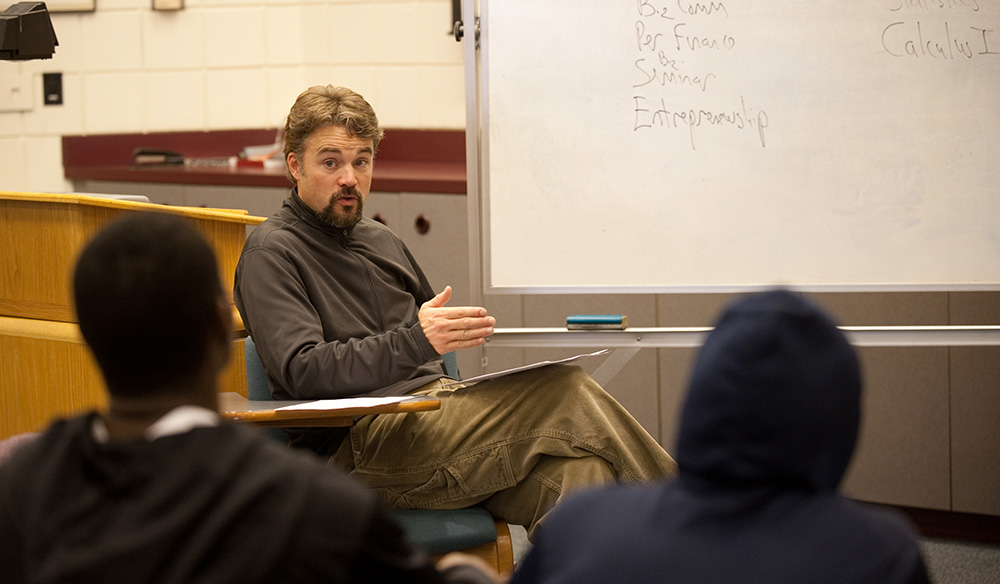Hesston College exists as a place of learning for students – academically, spiritually and socially. It’s why the college’s founders dreamt it into existence 102 years ago.
At Hesston, professors sometimes double as ones who not only teach, but also learn from students.
Business instructor, David LeVan, now in his third year at Hesston, fully embraces the idea of assessments – such as student, faculty and alumni evaluation surveys – as learning tools for improving his classes and discovering ways a new generation of students learns best.
“I am a firm believer in assessment because it is a way to visually see where improvement is needed,” said LeVan. “All criticism contains a kernel of truth, and while it’s not always fun to hear it can be a clear indicator of where change is needed.”
After his first year of teaching, students in LeVan’s Business Communication and Exploring Business classes evaluated the courses using the Individualized Developmental Education Assessment (IDEA) survey. To LeVan’s dismay, both courses scored below the Hesston College average.
LeVan wanted to ensure his students were getting the most from his courses, so he studied the survey results and addressed the areas students indicated having the most trouble or lack of comprehension. One year later, the scores from the student survey came back showing vast improvements in all areas.
“I like teaching because it allows me to continuously improve as an instructor and strengthen the content of my courses,” said LeVan. “Assessment vehicles like the IDEA survey force me to confront weaknesses and offer me the opportunity to improve and grow.”
Surveys and other self-assessment tools have been used at Hesston for many years, but were primarily locally generated until the fall of 2006 when the college made the switch to using nationally recognized and normed assessment methods like the IDEA survey.
IDEA provides institutional information, results for individual courses and measures the students’ perception of the quality of the course and instruction. Since the college’s first run with IDEA in 2006, summary results show the percent of Hesston College courses ranking above average among the other 380 two-year and four-year institutions that use the survey increased from 51 percent to 76 percent during the spring 2011 semester. IDEA states that “when this percentage exceeds 60 percent, the inference is that the college’s overall instructional effectiveness was unusually high.”
Translation: overall, Hesston College has unusually effective instructors.
“Assessment allows the faculty as a whole to identify areas we don’t meet the benchmarks we set for ourselves and find ways to improve,” said Dr. Sandra Zerger, vice president of Academics at Hesston. “Improvements do not happen automatically. It’s a process of evaluation and receiving the information and support to make changes. I think, as a whole, faculty recognize the value in assessment because they see the progress that has been made.”
“I appreciate that Hesston College encourages us to ask, ‘How can we do better?’ and then actually works toward doing better,” said LeVan.
Hesston instructors are required to use the IDEA survey in at least one course every semester. LeVan uses it in every class every semester.
“I want to track the progress of my classes,” said LeVan. “I want to find the gaps throughout the course and improve those areas from one year to the next. After my first year, I realized that my students were unclear about what I was doing in class. I redesigned my curriculum to be very outcome driven. I want my students to understand what I expect. I hope they feel empowered by that.”
The results from year one to year two indicate that the changes LeVan implemented made a difference to his students as each measured benchmark area significantly improved.
“David’s classes are never about memorization, but about understanding concepts and applying them to real life settings” said sophomore Joel Murray of Hesston, Kan. “I feel prepared in his classes because he makes sure we have a good grasp of the course content.”
In an effort to be a better resource to his advisees, LeVan also performed a transferability audit on the college’s business courses and those of schools where many Hesston students transfer. His findings gave him a clearer picture of how to guide students through their first two years of a business program and how to make the transfer process work.
“It is critical that we know what our students need to transfer and the courses they have to take in order to be successful,” LeVan said. “We have an obligation to ensure Hesston College students are well prepared to move on after two years.”


